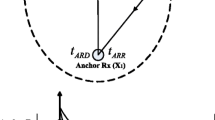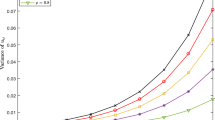Abstract
In this paper, a novel localization algorithm is proposed by utilizing the time difference of arrival (TDOA) with asynchronous base stations. Generally, a TDOA-based localization algorithm requires synchronization between base stations. Hence, correlations using wideband signals or wire connections between base stations have been used to synchronize the base stations; however, these approaches result in localization error by synchronization error between base stations. Thus, the proposed algorithm does not require synchronization between base stations. The TDOA equations of proposed algorithm are derived by continuously varying the locations of the mobile station and the location of a base station. Localization procedure is also reduced. The localization performance of the proposed algorithm is verified with Monte-Carlo simulations.



Similar content being viewed by others
References
Gezici, S., & Poor, H. V. (2009). Position estimation via ultra-wide-band signals. In Proceedings of the IEEE—special issue on UWB technology and emerging applications, vol. 97(2), (pp. 386–403).
Yang, K., An, J., Bu, X., & Sun, G. (2010). Constrained total least-squares location algorithm using time-difference-of-arrival measurements. IEEE Transactions on Vehicular Technology, 59(3), 1558–1562.
Wu, Y. C. (2011). Clock synchronization for wireless sensor netwroks. IEEE Signal Processing Magazine, 28(1), 124–138.
Gezici, S. (2005). Localization via ultra-wideband radios: A look at positioning aspects for future sensor networks. IEEE Signal Processing Magazine, 22(4), 70–84.
Fang, B. T. (1990). Simple solutions for hyperbolic and related position fixes. IEEE Transactions on Aerospace and Electronic Systems, 26(5), 748–753.
Sharp, I., Yu, K., & Guo, Y. J. (2009). GDOP analysis for positioning system design. IEEE Transactions on Vehicular Technology, 58(7), 3371–3382.
Jang, S. H., et al. (2011). SNR enhancement algorithm using multiple chirp symbols with clock drift for accurate ranging. ETRI Journal, 33(6), 841–848.
IEEE Computer Society. (2007). IEEE Std. 802.15.4a—2007. IEEE Computer Society, LAN/MAC Standard Committee, “IEEE P802.15.4a/D7 (amendment of IEEE std 802.15.4), part 15.4: wireless medium access control (MAC) and physical layer (PHY) specifications for low-rate wireless personal area networks,” Jan. 2007.
Schwalowsky, S., Trsek, H., Exel, R., & Kero, N. (2010). System integration of an IEEE 802.11 based TDOA localization system. In 2010 international IEEE symposium on precision clock synchronization for measurement control and communication (pp. 55–60).
Rahman, M. D., & Yu, K. B. (1987). Total least squares approach for frequency estimation using linear prediction. IEEE Transactions on Acoustic Speech and Signal Processing, ASSP-35(5), 1440–1454.
IEEE 802.15.4a-2007. (2007). Part 15.4: Wireless medium access control (MAC) and physical layer (PHY) specifications for low-rate wireless personal area networks (WPANs); Amendment 1: Add Alternate PHYs.
Chan, Y. T., & Ho, K. C. (1994). A simple and efficient estimator for hyperbolic location. IEEE Transactions on Signal Processing, 42(8), 1905–1915.
Author information
Authors and Affiliations
Corresponding author
Rights and permissions
About this article
Cite this article
Kim, SD., Chong, JW. A Novel TDOA-Based Localization Algorithm Using Asynchronous Base Stations. Wireless Pers Commun 96, 2341–2349 (2017). https://doi.org/10.1007/s11277-017-4301-5
Published:
Issue Date:
DOI: https://doi.org/10.1007/s11277-017-4301-5




